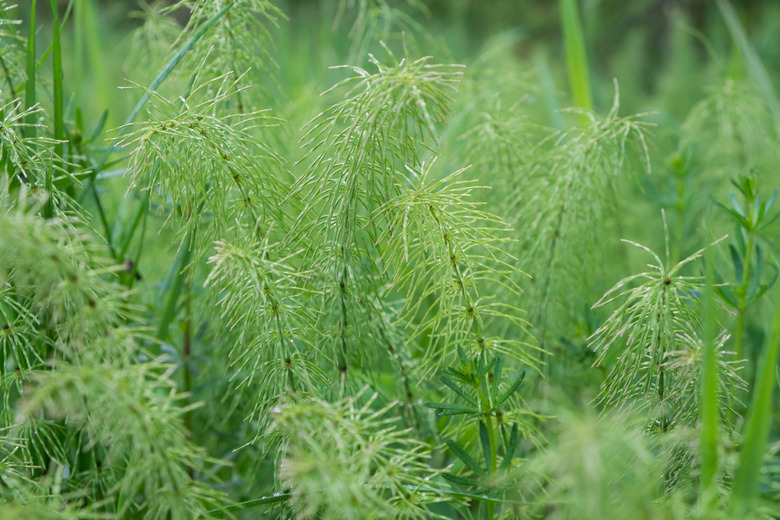Weeds That Look Like Pine Trees
Two troublesome weeds that look like small pine trees at some point in their development are field horsetail (Equisetum arvense, USDA zones 3-11) and annual Russian thistle (Salsola tragus). The former is a native of North America and Europe and can be toxic to grazing animals. The latter, introduced by Russian immigrants to the American West, changes in appearance from miniature pine to the bushy tumbleweed known for blowing through ghost towns.
Farmers' Nemesis: Field Horsetail
Farmers' Nemesis: Field Horsetail
Field horsetail causes problems with its extensive tubers and rhizomes. In its vegetative stage, this perennial grows plume branches that resemble tiny pine trees — or horsetails — and these green stems grow up to 2 feet tall. The rhizomes, from which this plant spreads and propagates, are very deep, sometimes to 6 feet, which makes this plant difficult to eradicate.
These plants pose problems for farmers, depending on the crops they plant: Healthy fields of grain often stave off infestations, but slow-growing species and short vegetables may not be vigorous enough to compete with field horsetail.
Field Horsetail Management
Field Horsetail Management
This plant cannot be easily controlled through mere mechanical means, that is, tilling or digging, since this just serves to spread the plant via its rhizomes. To manage the weed, consider quarantining, enhancing drainage and planting more-competitive grain varieties.
Additionally, nitrogen works for grass crops because they react more vigorously to the fertilizer than field horsetail does. Herbicide applications include primisulfuron and MCPA. Applications for areas without crops include sulfometuron and chlorsulfuron. Dichlobenil also is used in some instances.
Prickly Russian Thistle
Prickly Russian Thistle
Russian thistle is a common pest species in the western United States, where it infests roughly 100 million acres. A native of southeast Russia and western Siberia, this annual was introduced to the United States in the 19th century. It often grows in vegetable fields and in disturbed areas such as beside roadways. In some areas, Russian thistle can be useful as forage for cattle, horses and sheep, as it has a high nutritional value, especially once the plant has dried.
This plant's seedlings resemble small pine trees, but once they're older, Russian thistles are bushy, bristly and grow up to 6 feet tall. These plants break off at ground level when their stems dry, and the wind blows the tumbleweeds across the landscape, enabling the plants to scatter seeds.
Russian Thistle Management
Russian Thistle Management
While cattle can eat the young plants, Russian thistle still causes considerable problems. For instance, the species diminishes yields of crops such as alfalfa, and the plants harbor pest insects. Also, the tumbleweeds can be dangerous to drivers and are a fire hazard.
Control is difficult; methods include mowing, burning and planting competing species. Blister mites, which target only the Russian thistle, are another possible control. Also, pre-emergent herbicides such as atrazine can keep Russian thistle from germinating. Post-emergent herbicides are also used, but when the plants are still seedlings. Eradication can also focus on minimizing its disturbance and planting competing vegetation, which can result in a declining thistle population.
